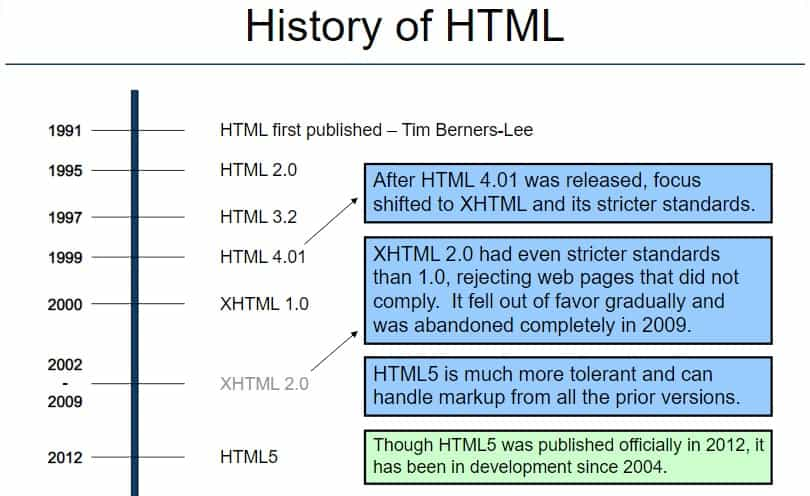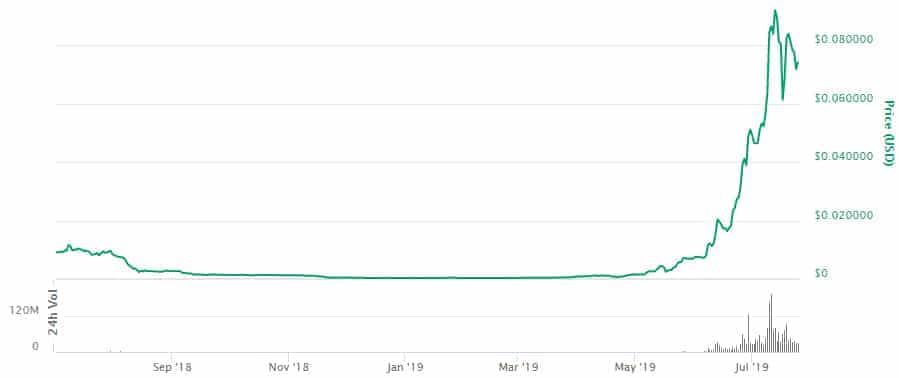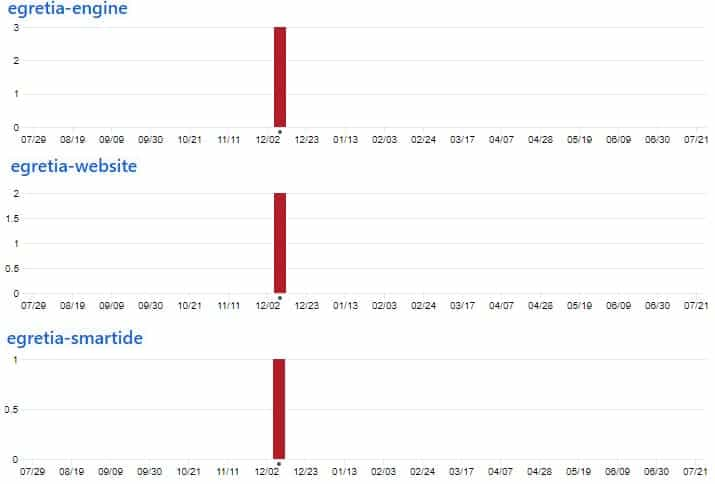Egretia Review: The First HTML5 Blockchain Engine & Platform
Egretia (EGT) isn’t a brand new blockchain project, it’s been around for nearly 2 years. It isn’t even a new token, the ICO was held in May 2018.
But it has captured many trader’s attention recently as it has skyrocketed into the top 50 on the CMC rankings. This is on the back of a price rally that saw it go from below $0.0001 in April 2019 to highs above $0.08 in July 2019.
So, what is Egretia and is this sustainable?
In this Egretia review, I will give you everything you know and attempt to answer that. Before we can do that though, I need to give you a bit of background on HTML5.
Overview of HTML5
Those familiar with the web know about HTML5, the structured language used to present content on the World Wide Web. It has been around for quite some time, with the initial development dating back to 2004, but it took some time for it to catch on.
Firefox was the first large company to add HTML support in 2008, with others such as YouTube, Twitter, LinkedIn, Flickr and others adding HTML5 support in the following years. But all of them found that developing HTML5 applications was difficult and expensive, and so the HTML5 standard fell by the wayside.

The rise of smartphones and instant messaging apps changed that, and HTML5 is now used extensively in the gaming market. It’s estimated that HTML5 gaming apps reach some 4 billion users through various messaging apps.
And yet there are still issues with HTML5 being used in gaming apps. These issues are highlighted as follows:
- Because there is no global payment platform for these HTML5 games users incur additional risks when using credit card payments.
- Users don’t have true ownership of digital in-game assets that are stored on company servers.
- There is no better alternative for storing digital in-game assets.
- Monetizing game traffic effectively is difficult for game developers.
- Protecting intellectual rights for HTML5 products is difficult.
All of this adds up to a lack of incentive for developers to create high-quality games. This is where Egretia comes in...
What is Egretia?
Egretia was created to solve these problems by developing an HTML5 game engine based on blockchain technology. The technology developed by Egretia already reaches more than 1 billion mobile terminals and is supported by 200,000 developers.
You might wonder how this is possible for such a new project. It happens because Egretia is working together with Egret Technology, a company that has spent four years perfecting HTML5 workflow.

That workflow now includes 14 products and reaches more than 200,000 developers. And the content being powered by the workflow has been distributed to more than 1 billion mobile terminals.
Egretia has taken the proven workflow developed by Egret and placed it into a blockchain interface layer. This gives HTML5 games and developers access to a complete blockchain development suite. And it not only supports Egretia’s blockchain but can be extended in the future to include Ethereum and any other public chains.
Egretia is constructing a complete ecosystem that has blockchain solutions that include developers, content-providers, the players as well as advertisers and delivery channels.
Egretia’s Platform and Features
The Egretia platform has plans to include the following components, all of which help in solving the problems already highlighted above. The main platform components currently planned are as follows:
- Digital Asset Exchange – This platform will allow players to create their own games that will be able to exchange digital assets with other games. It is planned for release in the third quarter of 2019.
- Advertising – The ad platform will allow for smart contracts and electronic payments where anyone will be able to purchase advertising space on blockchain-based games.
- Gaming Platform – This is where players will go to access and play the blockchain-based games. It will use a Proof-of-Game consensus mechanism to generate rewards for players. It was planned for a second-quarter 2019 release, and the testnet went live on June 4, 2019.
- Egretia Nursery – This will be an incubation area that will support the creation of teams that allow for a bridge between developers and players.
- Storage Platform – Developers will be able to store all game objects and data right on the Egretia blockchain using the storage platform.
- Game Development Platform - This is where developers will go to create HTML5 games. Includes the Egretia Engine, Egretia Server, and Egretia SmartIDE.
Egretia began on the Ethereum blockchain but has recently transitioned to its own testnet. It plans on launching the mainnet in the second quarter of 2020. The blockchain will then have its own native token and the following features:
- Delegated Proof-of-Stake (DPoS) consensus mechanism, similar to EOS.
- Initial speeds of 2,000 transactions per second. The development team claims this can be increased as needed through the DPoS mechanism.
- Flexibility built into the blockchain, allowing for easy changes in block creation times, block size, and transaction fees. All will be decided by voting among the nodes.
- In keeping with the flexibility goals, the development toolkit used by Egretia will support many different programming languages.
The Egretia Team
The Egretia core development team is built around the two founders of Egretia, the founder of Egret, and two additional members.
The leader of the Egretia team is CEO and founder Peter Huang. Prior to founding Egretia, he was also a co-founder at Egret, and the transition to the blockchain was a natural one for him. Formerly a technical manager at Adobe Systems, he has over 18 years of experience in game development and internet projects.
The co-founder of Egretia is Dirk Meyer, and while he is part of the Egretia Blockchain team it doesn’t appear that he is working full time on the project as his LinkedIn profile shows him as simply a team member, and also shows him working as Sr. Program Manager, Creative Cloud, Digital Media at Adobe Systems.

Another member of the Egretia Blockchain team as a leader of research and development is Edwin Chen. He is also the founder and CEO of Egret, which gives him close ties to the Egretia project.
Much of the technical work is being done by Yin Ma, who previously worked for Qualcomm and is a compiler and toolchain expert with over 20 years experience in compiler development.
The final core member of the Egretia Blockchain team is Ross Przybylski, who is also the founder of D20Studios and former producer at Electronic Arts. He brings more than 15 years of software development experience to the project, along with over 10 years of game development experience.
Egretia Community
As you might expect from an unknown project Egretia doesn’t have a huge social media following. They have seen their Twitter account attract a large following over the past two months in response to the huge jump in the value of EGT.
There are now roughly 41,300 Twitter followers. The Facebook account also appears to have seen rapid growth in the past few months and now has just under 3,600 followers of their page.
Other accounts don’t show that rapid growth and remain small. The Egretia sub-Reddit has less than 1,000 readers and very little activity, especially prior to June 2019. The Telegram channel is only 1,893 members as well, which is fairly low in the blockchain space.
The EGT Token
The EGT token is what’s brought the Egretia project to light recently as it has surged an insane 20,000%+ since the start of the year, bringing it to the 32nd position based on market cap and making it the best gainer of 2019 by far.
The move higher began in late May and has accelerated in June and through early July. The jump is almost certainly in response to the launch of the testnet for the project, but considering the early stages of development, it seems extremely overdone.
Some have suggested it’s a typical pump of a worthless coin, but if that were the case we should have seen the price rising for no more than a week or two, followed by a crash back to its original price.

That hasn’t been the case with EGT, which is off its high of $0.095559 set on July 10, 2019, but remains above the $0.07 level as of July 24. And that pullback has come as the overall cryptocurrency market has begun to show some weakness.
The EGT token is an ERC-20 token, but a native token will be launched when the team launched the mainnet sometime in 2020. The token was launched via an ICO back in May 2018, and it was well-received, with the team raising $23,650,000 in under 24 hours.
At the time EGT tokens were offered for $0.00858 each, meaning those who bought during the ICO have seen returns of more than 800% from the ICO price. In actuality, however, the returns have been far greater in ETH terms. Tokens bought with ETH have seen an increase of more than 24,000% in ETH terms since the ICO.
Buying & Storing EGT
Those who feel there’s still upside for the EGT token can purchase it from a number of exchanges.
The largest volume is on the OKEx platform, followed by CoinTiger. There is also a growing amount of volume from HTX, (previously Huobi Global), where the EGT token was just listed on July 10. Ironically that’s also the date of the all-time high for the token.
Something that did quite surprise me was the extensive volume of the token especially on the likes of OKEx. This volume is more than I have seen even with some of the most well known tokens. So, this implies a strong degree of liquidity for large block orders.

There is a risk here and that is key exchange risk. Volumes on OKEx are 80% of the total for EGT. This means that liquidity could fall dramatically in the case of any issues at OKEx.
Now, once you have your EGT Tokens you are going to want to remove them from the exchange and store them in an offline wallet. We are all well aware of the risks that come from centralised exchange hacks.
Because EGT is an ERC-20 token it can be stored in any ERC-20 compatible wallet. Additionally, the team has been working on their own wallet, which was due in the first quarter of 2019, but has been delayed.
Egretia Development & Roadmap
Sometimes it can be quite hard to determine exactly how much work is being done on a project. It is often the case that a team will overstate the progress of the project.
However for me, one of the most concrete ways to determine progress is the activity in their public code repositories. Hence, I decided to jump into Egretia's GitHub and take a look at their code commits. Below is the code commits of their top three pinned repositories.

As you can see from the above, these are some pretty barren repositories. They only pushed a handful of commits through these repositories on the same day last year. Although there are a further 7 repos, they are all just as dry.
Clearly, this is not the best sign from a project especially one that is supposed to be developing an open source blockchain engine.
Of course, it is most likely that the team is developing their protocol offline or are working in private repositories. Yet, it still helps if they are able to share the live progress of the project with their community.
Having said that, they do seem to have some important updates planned at least as it pertains to their official Roadmap. Below are what they have laid out for the rest of 2019 and 2020:
- 2019 Q2: Release of the blockchain games platform
- 2019 Q3: Virtual Goods Trading Release
- 2019 Q4: Advertising Platform
- 2020 Q1: Public Chain Release Candidate
- 2020 Q2: Egretia Public Chain 1.0 Release
Given that we cannot see direct progress in the repositories of the project, we are going to have to rely on the development updates that they may post on their official blog.
Conclusion
To be honest, the huge gains made by the token of this previously unknown project seem suspect. While blockchain gaming is almost certainly going to be a very profitable sector in the future, the Egretia platform is not only untested, it is pretty much undeveloped. While it does show promise, that isn’t enough to justify a 20,000% gain. In short, I think the token will come back to earth.
The success of the project depends on how rapidly they can develop and launch their HTML5 blockchain integration. Mobile gaming is a huge industry, and it’s been forecast that HTML5 gaming will reach $100 billion in revenue in the coming decade.
With its partnership with Egret Technology and their community of over 200,000 developers, Egretia is well-positioned for success. They should be able to leverage the partnerships Egret also enjoys with Tencent, Xiaomi and Microsoft and the 75% domination over the Chinese HTML5 game market.
The launch of the testnet is another positive, but some of the checkpoints on the roadmap are delayed, and that’s never good. It can be hoped that these delays will not become a trend, because that could set the project back enough to allow competition to catch-up and overtake the lead that Egretia has built.
Overall Egretia has a very good proposition, now it’s up to them to deliver on the promise.
Disclaimer: These are the writer’s opinions and should not be considered investment advice. Readers should do their own research.
